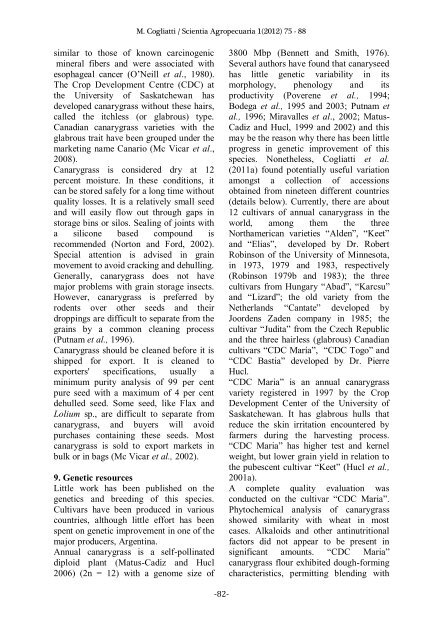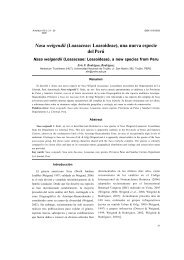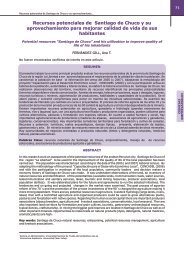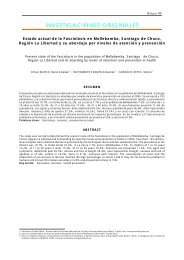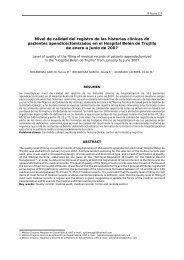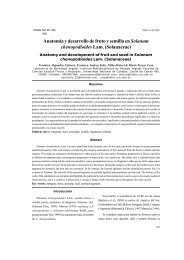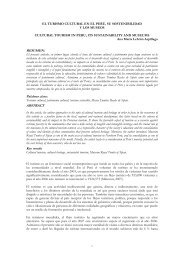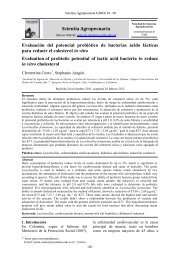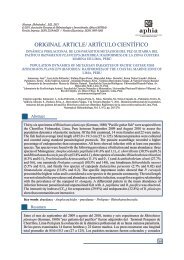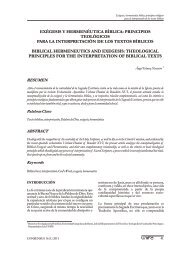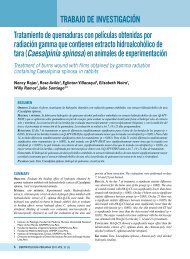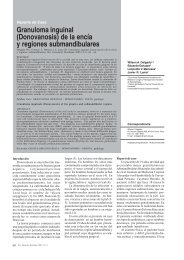ARTÃCULO DE REVISIÃN Canaryseed Crop Cultivo de ... - Dialnet
ARTÃCULO DE REVISIÃN Canaryseed Crop Cultivo de ... - Dialnet
ARTÃCULO DE REVISIÃN Canaryseed Crop Cultivo de ... - Dialnet
- No tags were found...
Create successful ePaper yourself
Turn your PDF publications into a flip-book with our unique Google optimized e-Paper software.
M. Cogliatti / Scientia Agropecuaria 1(2012) 75 - 88similar to those of known carcinogenicmineral fibers and were associated withesophageal cancer (O’Neill et al., 1980).The <strong>Crop</strong> Development Centre (CDC) atthe University of Saskatchewan has<strong>de</strong>veloped canarygrass without these hairs,called the itchless (or glabrous) type.Canadian canarygrass varieties with theglabrous trait have been grouped un<strong>de</strong>r themarketing name Canario (Mc Vicar et al.,2008).Canarygrass is consi<strong>de</strong>red dry at 12percent moisture. In these conditions, itcan be stored safely for a long time withoutquality losses. It is a relatively small seedand will easily flow out through gaps instorage bins or silos. Sealing of joints witha silicone based compound isrecommen<strong>de</strong>d (Norton and Ford, 2002).Special attention is advised in grainmovement to avoid cracking and <strong>de</strong>hulling.Generally, canarygrass does not havemajor problems with grain storage insects.However, canarygrass is preferred byro<strong>de</strong>nts over other seeds and theirdroppings are difficult to separate from thegrains by a common cleaning process(Putnam et al., 1996).Canarygrass should be cleaned before it isshipped for export. It is cleaned toexporters' specifications, usually aminimum purity analysis of 99 per centpure seed with a maximum of 4 per cent<strong>de</strong>hulled seed. Some seed, like Flax andLolium sp., are difficult to separate fromcanarygrass, and buyers will avoidpurchases containing these seeds. Mostcanarygrass is sold to export markets inbulk or in bags (Mc Vicar et al., 2002).9. Genetic resourcesLittle work has been published on thegenetics and breeding of this species.Cultivars have been produced in variouscountries, although little effort has beenspent on genetic improvement in one of themajor producers, Argentina.Annual canarygrass is a self-pollinateddiploid plant (Matus-Cadiz and Hucl2006) (2n = 12) with a genome size of3800 Mbp (Bennett and Smith, 1976).Several authors have found that canaryseedhas little genetic variability in itsmorphology, phenology and itsproductivity (Poverene et al., 1994;Bo<strong>de</strong>ga et al., 1995 and 2003; Putnam etal., 1996; Miravalles et al., 2002; Matus-Cadiz and Hucl, 1999 and 2002) and thismay be the reason why there has been littleprogress in genetic improvement of thisspecies. Nonetheless, Cogliatti et al.(2011a) found potentially useful variationamongst a collection of accessionsobtained from nineteen different countries(<strong>de</strong>tails below). Currently, there are about12 cultivars of annual canarygrass in theworld, among them the threeNorthamerican varieties “Al<strong>de</strong>n”, “Keet”and “Elias”, <strong>de</strong>veloped by Dr. RobertRobinson of the University of Minnesota,in 1973, 1979 and 1983, respectively(Robinson 1979b and 1983); the threecultivars from Hungary “Abad”, “Karcsu”and “Lizard”; the old variety from theNetherlands “Cantate” <strong>de</strong>veloped byJoor<strong>de</strong>ns Za<strong>de</strong>n company in 1985; thecultivar “Judita” from the Czech Republicand the three hairless (glabrous) Canadiancultivars “CDC María”, “CDC Togo” and“CDC Bastia” <strong>de</strong>veloped by Dr. PierreHucl.“CDC Maria” is an annual canarygrassvariety registered in 1997 by the <strong>Crop</strong>Development Center of the University ofSaskatchewan. It has glabrous hulls thatreduce the skin irritation encountered byfarmers during the harvesting process.“CDC Maria” has higher test and kernelweight, but lower grain yield in relation tothe pubescent cultivar “Keet” (Hucl et al.,2001a).A complete quality evaluation wasconducted on the cultivar “CDC Maria”.Phytochemical analysis of canarygrassshowed similarity with wheat in mostcases. Alkaloids and other antinutritionalfactors did not appear to be present insignificant amounts. “CDC Maria”canarygrass flour exhibited dough-formingcharacteristics, permitting blending with-82-


